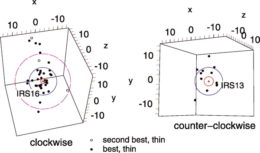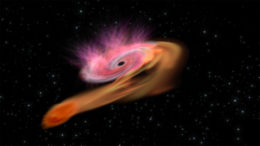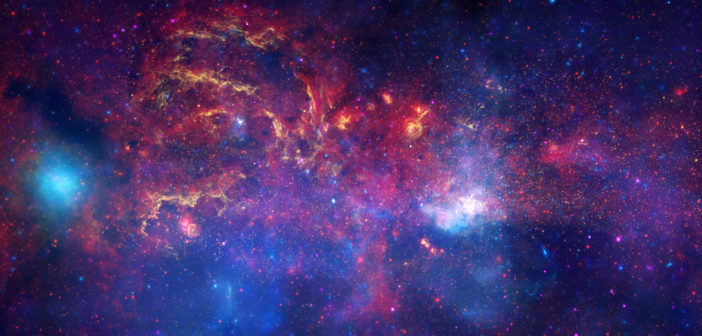The massive young stars at the center of the Milky Way have long puzzled astronomers. Did these stars form in a supermassive black hole’s backyard, or did they travel to the galactic center after their birth? In a recent publication, researchers proposed an entirely new scenario, in which the demise of one star prompts the formation of many more.
Born in a Black Hole’s Shadow

Locations of stars belonging to the putative clockwise and counter-clockwise disks at the center of the Milky Way. Distances are given in arcseconds. Click to enlarge. [Paumard et al. 2006]
The presence of young stars in the hostile inner regions of our galaxy is mysterious enough, and this arrangement is even more perplexing. It’s not yet clear how stars might form so close to a black hole — the tidal forces should prevent new stars from coalescing — and the disk-like arrangement shouldn’t arise naturally if the stars migrated from elsewhere in the galaxy. How did these stars come to be where they are?

Diagram of the jet–cocoon configuration. Because the pressure within the cocoon exceeds the pressure of the surrounding gas clouds, the cocoon sweeps outward and compresses the clouds nearby. [Perna & Evgeni 2022]
From Disruption to Disk Formation
Rosalba Perna (Stony Brook University and Flatiron Institute) and Evgeni Grishin (Monash University and Australian Research Council Centre of Excellence for Gravitational Wave Discovery) proposed that when a star is tidally disrupted by a supermassive black hole, it creates the conditions for new stars to form.
Here’s how it works: in rare cases, as a star is being pulled apart by a black hole, it shoots out a jet of material. A cocoon of gas enclosing this jet expands perpendicular to the jet, compressing the surrounding gas and providing enough pressure for gas clumps to overcome the black hole’s tidal pull and form new stars.
While the expanding cocoon spurs star formation perpendicular to the jet, the jet itself creates a cone of superheated gas that suppresses star formation along its length. The combination of these factors promotes star formation in a thin disk, and the orientation of the disk is linked to the orbit of the disrupted star. In other words, the team expects that a tidally disrupted star will lead to a disk of stars forming at a random angle with respect to the galactic plane — exactly the arrangement we see at the center of the Milky Way.
More to Learn

An artist’s impression of a tidal disruption event. [ESA/C. Carreau]
While this scenario laid out by Perna and Grishin appears to answer many of the questions regarding the stars arrayed in disks near the center of the Milky Way, the authors acknowledged that their hypothesis needs to be tested thoroughly. Hopefully, future numerical simulations will help us close in on the formation mechanism for these galactic center stars!
Citation
“Disks of Stars in the Galactic Center Triggered by Tidal Disruption Events,” Rosalba Perna and Evgeni Grishin 2022 ApJL 939 L17. doi:10.3847/2041-8213/ac99d8

